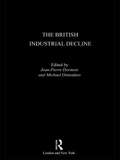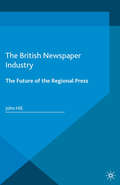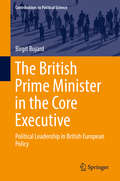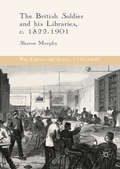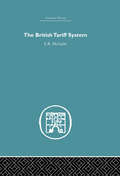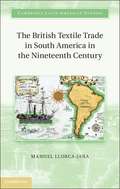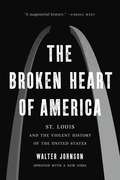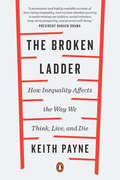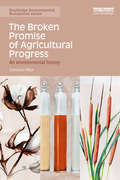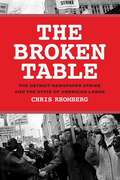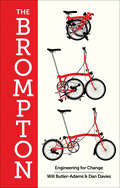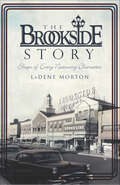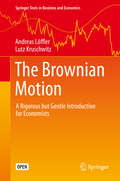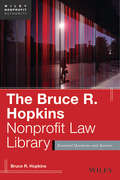- Table View
- List View
The British Industrial Decline (Routledge Explorations in Economic History #10)
by Jean-Pierre Dormois Michael DintenfassThe decline of British Industry in the late Victorian and early Edwardian period is the subject of major concern to economic and modern British historians. This book sets out the present state of the discussion and introduces new directions in which the debate about the British decline is now proceeding: Among other themes, the book examines: * the role of the service sector alongside manufacturing * the distinctiveness of the British regions * the state's role in the British decline including an analysis of its responsibility for the maintenance and modernization of infrastructure * the association of aristocratic values with entrepreneurial vitality * how British historians have discussed success and failure, with a critique of the literature of decline.
The British Industrial Revolution in Global Perspective
by Robert C. AllenWhy did the industrial revolution take place in eighteenth-century Britain and not elsewhere in Europe or Asia? In this convincing new account Robert Allen argues that the British industrial revolution was a successful response to the global economy of the seventeenth and eighteenth centuries. He shows that in Britain wages were high and capital and energy cheap in comparison to other countries in Europe and Asia. As a result, the breakthrough technologies of the industrial revolution - the steam engine, the cotton mill, and the substitution of coal for wood in metal production - were uniquely profitable to invent and use in Britain. The high wage economy of pre-industrial Britain also fostered industrial development since more people could afford schooling and apprenticeships. It was only when British engineers made these new technologies more cost-effective during the nineteenth century that the industrial revolution would spread around the world.
The British Labour Movement and Film, 1918-1939 (Routledge Library Editions: The Labour Movement #18)
by Stephen G. JonesFirst published in 1987. Using a wealth of primary sources, Stephen Jones investigates the role played in cinema affairs by the Labour Movement, stressing the important contributions made by the Labour Party, Communist Party and trade unions in the production and presentation of film. He gives us a rare and important insight into the British film industry, examining the cinema in its wider economic, political and cultural context. He explores the ideological influence of film, the nature of film work, state intervention and Sunday entertainment, as reflected in the policies and attitudes of organized labour. Also discussed are the growth and impact of independent working class film organization.
The British Monopolies Commission
by Charles K. RowleyThis book is a key example of the emergence of public choice theory by an economist who was to become one of its major exponents. It combines a detailed, critical study of the Monopolies Commission, with an analysis of the economic issues involved in monopoly supervision and control.
The British Newspaper Industry: The Future of the Regional Press
by John HillIt is never very obvious to spectators of the newspaper business just why it is that the industry has suffered so badly in recent years. Most ascribe the reasons to the arrival of the Internet in all its forms when, in truth, most of its problems were created by the newspaper managements themselves, either by weak management in the control of its environment, by a serious lack of foresight in looking to the future, or by assuming that change, if it were to come, would be at the slow pace of past change. The magisterial attitudes of most newspaper managements served to engender a growing resentment particularly among the advertisers who were forced to pay increased rates to enable the cover prices of the publications to be held down. The British Newspaper Industry sets out to distinguish the newspaper industry from the generality of single product organisations and to provide tailored solutions to its problems by drawing on a variety of techniques and practices successfully used in other industries.
The British Prime Minister in the Core Executive: Political Leadership in British European Policy (Contributions to Political Science)
by Birgit BujardThis book examines the UK prime minister’s political leadership in the domestic executive. By offering a comparative study of the political leadership of James Callaghan, Margaret Thatcher, John Major and Tony Blair with regard to European monetary policy, it challenges the thesis that British prime ministers today have more power, resources and autonomy than their predecessors, giving them a greater capacity to act. Taking key European monetary policy decisions by the British government between 1976 and 2007 as empirical cases, the book assesses the extent to which the political leadership of each prime minister was affected by the cabinet, the parliamentary party as well as the media, and the extent to which he or she was able to manage these factors. It becomes clear from this analysis that prime ministerial predominance is not as frequent as suggested, while collective leadership does not represent a return to cabinet government. Moreover, particularly the party in government affects the prime minister’s leadership by shaping his or her options on appointments (and therefore the composition of the core executive), and through its behaviour in parliament, e.g. through rebellions or the threat of them.
The British Soldier and his Libraries, c. 1822-1901
by Sharon MurphyThe British Soldier and his Libraries, c. 1822-1901 considers the history of the libraries that the East India Company and Regular Army respectively established for soldiers during the nineteenth century. Drawing upon a wide range of material, including archival sources, official reports, and soldiers' memoirs and letters, this book explores the motivations of those who were responsible for the setting up and/or operation of the libraries, and examines what they reveal about attitudes to military readers in particular and, more broadly, to working-class readers - and leisure - at this period. Murphy's study also considers the contents of the libraries, identifying what kinds of works were provided for soldiers and where and how they read them. In so doing, The British Soldier and his Libraries, c. 1822-1901 affords another way of thinking about some of the key debates that mark book history today, and illuminates areas of interest to the general reader as well as to literary critics and military and cultural historians.
The British State: A Warning
by Chris NinehamWhat happens if a radical government gets elected in Britain? How will the banks, the civil servants, the media and the military react? Is the idea of a British coup far-fetched? How can the left prepare? Chris Nineham addresses these questions by looking behind the myths at the reality of two hundred years of British state rule. He brings us a warning from history. Don&’t be fooled again, read this book.
The British Tariff System (Routledge Library Editions: International Trade Policy #5)
by E.B. McGuireThe aim of this book, first published in 1939, is to provide a comprehensive description of the protectionist system that had been in force in Britain since 1931. It explains the principles and difficulties involved in framing and administering a customs and excise tariff, which has both revenue and political purposes. The problems of tariff negotiating are discussed, and trade agreements made are summarized.
The British Tariff System (Routledge Library Editions: International Trade Policy Ser. #5)
by E.B. McGuireThis book provides a comprehensive description of the protectionist system that has for some years been in force in Great Britain. It explains in simple language the principles and difficulties involved in framing and administering a customs and excise tariff, which has both revenue and political purposes. There is a in-depth description of the United Kingdom collecting machinery, an historical account of the tariff since 1914, and a discussion of the political objects such as Imperial Preference. The problems of tariff negotiating are discussed, and trade agreements made, including that with the U.S.A., are summarized.
The British Textile Trade in South America in the Nineteenth Century
by Manuel Llorca-JañaThis is the first work on British textile exports to South America during the nineteenth century. During this period, textiles ranked among the most important manufactures traded in the world market and Britain was the foremost producer. Thanks to new data, this book demonstrates that British exports to South America were transacted at very high rates during the first decades after independence. This development was due to improvements in the packing of textiles; decreasing costs of production and introduction of free trade in Britain; falling ocean freight rates, marine insurance and import duties in South America; dramatic improvements in communications; and the introduction of better port facilities. Manuel Llorca-Jaña explores the marketing chain of textile exports to South America and sheds light on South Americans' consumer behaviour. This book contains the most comprehensive database on Anglo-South American trade during the nineteenth century and fills an important gap in the historiography.
The British Worker Question: A New Look at Workers and Productivity in Manufacturing (Routledge Library Editions: Industrial Relations)
by Theo NicholsThe British Worker Question (1986) examines the productivity of British workers, drawing upon a wide range of management, trade union and other sources, and spanning the traditional preserves of several other areas and disciplines – economic history, industrial administration, industrial relations and Marxism. It criticises much earlier research for its lack of a grounded sociological analysis of both workers and managements and for its lack of detailed attention to how goods and services are actually produced. The book accords a central place in its analysis of workers and productivity to the role of social organisation and management, matters which both the orthodox and Marxist traditions neglect.
The British in Argentina: Commerce, Settlers and Power, 1800–2000 (Britain and the World)
by David RockDrawing on largely unexplored nineteenth- and twentieth-century sources, this book offers an in-depth study of Britain’s presence in Argentina. Its subjects include the nineteenth-century rise of British trade, merchants and explorers, of investment and railways, and of British imperialism. Spanning the period from the Napoleonic Wars until the end of the twentieth century, it provides a comprehensive history of the unique British community in Argentina. Later sections examine the decline of British influence in Argentina from World War I into the early 1950s. Finally, the book traces links between British multinationals and the political breakdown in Argentina of the 1970s and early 1980s, leading into dictatorship and the Falklands War. Combining economic, social and political history, this extensive volume offers new insights into both the historical development of Argentina and of British interests overseas.
The British on Holiday
by Hazel AndrewsThis book is the only in-depth ethnographic study of British charter tourists. It is based on several months of participant observation of British charter tourists on holiday in Palmanova and Magaluf on the Mediterranean Island of Mallorca. With a focus on space, the body, and food and drink practices, the book explores the experiential nature of touristic practice which provides insight into constructions, understandings and knowledge of the self in relation to national, regional, class, and gender identities. These issues in turn highlight elements of power and control which are mainly articulated through the attempts to manipulate tourists' consumption practices by the mediators of tourists' experiences.
The Broken Heart of America: St. Louis and the Violent History of the United States
by Walter JohnsonA searing portrait of the racial dynamics that lie inescapably at the heart of our nation, told through the turbulent history of the city of St. Louis.From Lewis and Clark's 1804 expedition to the 2014 uprising in Ferguson, American history has been made in St. Louis. And as Walter Johnson shows in this searing book, the city exemplifies how imperialism, racism, and capitalism have persistently entwined to corrupt the nation's past. St. Louis was a staging post for Indian removal and imperial expansion, and its wealth grew on the backs of its poor black residents, from slavery through redlining and urban renewal. But it was once also America's most radical city, home to anti-capitalist immigrants, the Civil War's first general emancipation, and the nation's first general strike -- a legacy of resistance that endures. A blistering history of a city's rise and decline, The Broken Heart of America will forever change how we think about the United States.
The Broken Ladder: How Inequality Affects the Way We Think, Live, and Die
by Keith PayneA timely examination by a leading scientist of the physical, psychological, and moral effects of inequality. Today’s inequality is on a scale that none of us has seen in our lifetimes, yet this disparity between rich and poor has ramifications that extend far beyond mere financial means. In The Broken Ladder psychologist Keith Payne examines how inequality divides us not just economically, but has profound consequences for how we think, how our cardiovascular systems respond to stress, how our immune systems function, and how we view moral ideas like justice and fairness. Experiments in psychology, neuroscience, and behavioral economics have not only revealed important new insights on how inequality changes people in predictable ways, but have provided a corrective to our flawed way of viewing poverty as the result of individual character failings. Among modern, developed societies, economic inequality is not primarily about money, but rather about relative status: where we stand in relation to other people. Regardless of their average income, countries or states with greater levels of income inequality have much higher rates of all the social problems we associate with poverty, including lower average life expectancies, serious health issues, mental illness, and crime. The Broken Ladder explores such issues as why women in poor societies often have more children, and have them younger; why there is little trust among the working class that investing for the future will pay off; why people’s perception of their relative social status affects their political beliefs, and why growing inequality leads to greater political divisions; how poverty raises stress levels in the same way as a physical threat; inequality in the workplace, and how it affects performance; why unequal societies become more religious; and finally offers measures people can take to lessen the harm done by inequality in their own lives and the lives of their children.
The Broken Promise of Agricultural Progress: An Environmental History (Routledge Environmental Humanities)
by Cameron MuirFood and the global agricultural system has become one of the defining public concerns of the twenty-first century. Ecological disorder and inequity is at the heart of our food system. This thoughtful and confronting book tells the story of how the development of modern agriculture promised ecological and social stability but instead descended into dysfunction. Contributing to knowledge in environmental, cultural and agricultural histories, it explores how people have tried to live in the aftermath of ‘ecological imperialism’. The Broken Promise of Agricultural Progress: An environmental history journeys to the dry inland plains of Australia where European ideas and agricultural technologies clashed with a volatile and taunting country that resisted attempts to subdue and transform it for the supply of global markets. Its wide-ranging narrative puts gritty local detail in its global context to tell the story of how cultural anxieties about civilisation, population, and race, shaped agriculture in the twentieth century. It ranges from isolated experiment farms to nutrition science at the League of Nations, from local landholders to high profile moral crusaders, including an Australian apricot grower who met Franklin D. Roosevelt and almost fed the world. This book will be useful to undergraduates and postgraduates on courses examining international comparisons of nineteenth and twentieth century agriculture, and courses studying colonial development and settler societies. It will also appeal to food concerned general readers.
The Broken Table
by Chris RhombergWhen the Detroit newspaper strike was settled in December 2000, it marked the end of five years of bitter and violent dispute. No fewer than six local unions, representing 2,500 employees, struck against the Detroit News, the Detroit Free Press, and their corporate owners, charging unfair labor practices. The newspapers hired permanent replacement workers and paid millions of dollars for private security and police enforcement; the unions and their supporters took their struggle to the streets by organizing a widespread circulation and advertising boycott, conducting civil disobedience, and publishing a weekly strike newspaper. In the end, unions were forced to settle contracts on management's terms, and fired strikers received no amnesty. In The Broken Table, Chris Rhomberg sees the Detroit newspaper strike as a historic collision of two opposing forces: a system in place since the New Deal governing disputes between labor and management, and decades of increasingly aggressive corporate efforts to eliminate unions. As a consequence, one of the fundamental institutions of American labor relations—the negotiation table—has been broken, Rhomberg argues, leaving the future of the collective bargaining relationship and democratic workplace governance in question. The Broken Table uses interview and archival research to explore the historical trajectory of this breakdown, its effect on workers' economic outlook, and the possibility of restoring democratic governance to the business-labor relationship. Emerging from the New Deal, the 1935 National Labor Relations Act protected the practice of collective bargaining and workers' rights to negotiate the terms and conditions of their employment by legally recognizing union representation. This system became central to the democratic workplace, where workers and management were collective stakeholders. But efforts to erode the legal protections of the NLRA began immediately, leading to a parallel track of anti-unionism that began to gain ascendancy in the 1980s. The Broken Table shows how the tension created by these two opposing forces came to a head after a series of key labor disputes over the preceding decades culminated in the Detroit newspaper strike. Detroit union leadership charged management with unfair labor practices after employers had unilaterally limited the unions' ability to bargain over compensation and work conditions. Rhomberg argues that, in the face of management claims of absolute authority, the strike was an attempt by unions to defend workers' rights and the institution of collective bargaining, and to stem the rising tide of post-1980s anti-unionism. In an era when the incidence of strikes in the United States has been drastically reduced, the 1995 Detroit newspaper strike stands out as one of the largest and longest work stoppages in the past two decades. A riveting read full of sharp analysis, The Broken Table revisits the Detroit case in order to show the ways this strike signaled the new terrain in labor-management conflict. The book raises broader questions of workplace governance and accountability that affect us all.
The Brompton: Engineering For Change
by Dan Davies William Butler-AdamsThe story of how Brompton, the iconic folding bicycle that you can take anywhere—and that can take you anywhere—grew from a small cult bike company to a multimillion-dollar business Lightweight, compact, distinctively styled, and now, electric: The Brompton isn’t the only folding bicycle—or even the first. But everyone who has been on one will enthusiastically testify to its marvelous design (virtually unchanged over decades) and the particular joy of riding it. Will Butler-Adams, CEO of Brompton Bicycles, has been at the company for twenty years. Initially, he worked as an engineer for Andrew Ritchie, the bike’s brilliant inventor and the business’s founder, before taking the helm in 2008. Butler-Adams’s heartfelt mission is to grow and promote sustainable urban transportation and to improve city-dwellers’ lives everywhere. Under his leadership, Brompton has grown from making a few hundred bikes a year to over 90,000, with revenue of $130 million. But progress hasn’t always been easy: There have been boardroom struggles, supply-chain problems, and conflicts with founder Andrew Ritchie. In The Brompton, Butler-Adams brings to life what it means to grow a company to global scale. He also tells the stories of the people who make the Brompton and the people who ride it. And he explains how customers all around the world fell in love with a brand that never set out to be a brand.
The Bronfman Dynasty; the Rothschilds of the New World
by Peter C. NewmanThe Bronfman family is a Canadian Jewish family who made a fortune with the family's Seagram Company.
The Bronfmans: The Rise and Fall of the House of Seagram
by Nicholas FaithFor decades, the Bronfman family ruled Seagram's and the liquor industry. This is the story of their meteoric rise and spectacular fall.The story of the Bronfman family is a fascinating and improbable saga. It is dominated by "Mr. Sam," the single greatest figure in the history of the liquor business, the man who made drinking whiskey respectable in the United States and who in the 1950s and 1960s built Seagram into the first worldwide empire in wine and spirits.After Sam's death in 1971, his oldest son, Edgar, maintained the business, though he was distracted by his matrimonial problems. Nevertheless, in the 1980s he masterminded a major coup when he translated a small investment in oil made by his father into a 25 percent stake in the mighty DuPont company. But in the 1990s, Edgar allowed his second son, Edgar Jr., to indulge his ambition to become a media tycoon. The stake in DuPont was sold, and the money reinvested in Universal, the film and theme-park empire. Edgar Jr. then paid more than $10 billion to buy Polygram Records and thus fulfill his fancy to be king of the world's music business. But at the same time, he remained in charge of the liquor business, which started to stagnate—indeed, to fall apart. Then came the final disaster when the increasingly divided family sold out to Jean-Marie Messier, overreaching empire builder of Vivendi, the French conglomerate. But the story of this amazing family over the past century is about more than booze and business. The Bronfmans is a spectacular account that details the larger-than-life personalities and bitter rivalries that have made the family so famous and, sometimes, so infamous.
The Bronx Community Foundation
by Aldo Sesia Brian TrelstadDerrick and Desmon Lewis were both successful professionals in the consulting and banking industries. They were born and raised in The Bronx, New York City's poorest borough. The Lewis brothers had always wanted to give back to the community. In 2016 they launched a community foundation-The Bronx Community Foundation-dedicated to improving the lives of Bronxites. While a lot of good had been happening in The Bronx, Derrick and Desmon believed that a community foundation would help to bring the systemic and institutional change to the borough; change they felt was necessary to bring economic, health, educational, etc., equality to The Bronx. Yet, nearly four years later, they had managed to raise little from donors; headwinds included those in the community who did not support the idea of a community foundation. When COVID-19 struck New York City in March 2020, the Lewises saw an opportunity to demonstrate the need for a place-based convener organization, such as a community foundation, in The Bronx. A relief effort was launched with a host of partners, which raised $10 million to help people of The Bronx who were impacted by COVID-19. Now in late July, the Lewises wanted to build on the momentum of the relief fund to finally get support and traction for the community foundation. They had much to decide: How to raise money for the foundation, which would need to come primarily from outside of the borough; who should lead the foundation; and what should be the foundation's operating model. The Lewises believed there was a window of opportunity that they needed to seize to turn their dream of a community foundation for The Bronx into a reality. The case provides an overview of community foundations in the U.S., an overview of The Bronx, The Bronx Community Relief Effort, and the Lewis brothers' early days and their efforts to start a community foundation, the opportunity, and the challenges.
The Brookside Story: Shops of Every Necessary Character (Brief History)
by LaDene MortonBrookside's burgundy-and-blue-striped awnings represent both a quaint corner of Kansas City where you can tread the creaky wooden floors of the Dime Store and a pragmatic philosophy that changed the way America planned its cities. Renowned developer J.C. Nichols's "plan for permanence" was built on his conviction that if a community could offer its residents everything they would want and need, build to high standards and plan for future growth, the community would last. The Brookside shopping district has been giving the community everything it could want and need since 1919, helping it weather economic turbulence, natural disasters and dramatic changes.
The Brownian Motion: A Rigorous but Gentle Introduction for Economists (Springer Texts in Business and Economics)
by Andreas Löffler Lutz KruschwitzThis open access textbook is the first to provide Business and Economics Ph.D. students with a precise and intuitive introduction to the formal backgrounds of modern financial theory. It explains Brownian motion, random processes, measures, and Lebesgue integrals intuitively, but without sacrificing the necessary mathematical formalism, making them accessible for readers with little or no previous knowledge of the field. It also includes mathematical definitions and the hidden stories behind the terms discussing why the theories are presented in specific ways.
The Bruce R. Hopkins Nonprofit Law Library
by Bruce R. HopkinsNeed a quick answer to a nonprofit legal conundrum? It's literally at your fingertips with The Bruce R. Hopkins Nonprofit Law Library. Supplying you with find-it-on-the-run answers to your nonprofit law questions, this Library prepares you to meet and manage your nonprofit's legal obligations with its step-by-step guidance. Packed with authoritative answers to the most essential questions on how to start a nonprofit organization; nonprofit law basics; maintenance of tax exemption; public charity rules; unrelated business rules; boards of directors and compensation; conflicts of interest; self-dealing; liability, and much more, this e-Library offers hands-on information mined from the following bestselling books and updated and expanded by the leading authority on nonprofit law, Bruce R. Hopkins:* Nonprofit Law for Religious Organizations: Essential Questions & Answers / Bruce R. Hopkins and David Middlebrook* 650 Essential Nonprofit Law Questions Answered / Bruce R. Hopkins* The Legal Answer Book for Private Foundations / Bruce R. Hopkins and Jody Blazek* Starting and Managing a Nonprofit Organization, Sixth Edition / Bruce R. Hopkins* Nonprofit Law for Colleges and Universities / Bruce R. Hopkins, Virginia C. Gross, and Thomas J. SchenkelbergFrom acquiring and maintaining tax-exempt status to fundraising regulation, The Bruce R. Hopkins Nonprofit Law Library gives you the legal guidance and practical insights you need--now.
